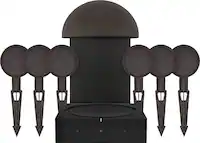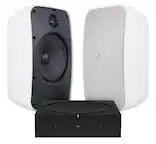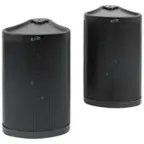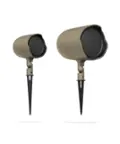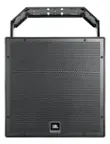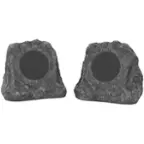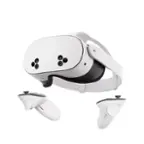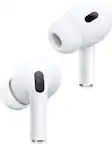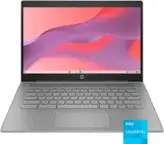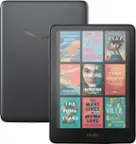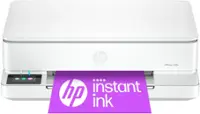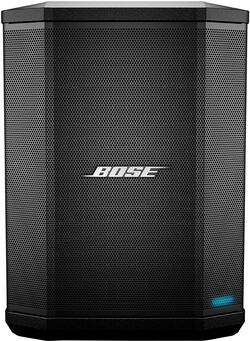
Bose - S1 Pro Portable Bluetooth Speaker without Battery - Black
- Key Specs
- Speaker Type: Floorstanding, Landscape
- RMS Power: 120 watts (The maximum amount of continuous power the device is able to handle.)
- Wireless Connectivity: Bluetooth (The manner in which a device sends data to another device over a short distance without the use of wires or cables.)
- General
- Brand: Bose
- Model Number: 787930-1110
- Product Name: S1 Pro Portable Bluetooth Speaker without Battery
- Color: Black
- Audio
- Speaker Type: Floorstanding, Landscape
- RMS Power: 120 watts (The maximum amount of continuous power the device is able to handle.)
- Minimum Frequency Response: 70 hertz (Describes the maximum range of frequencies or musical tones a product can reproduce, from very low tones to very high treble tones. The minimum frequency or musical tone the speaker can reproduce. High treble tones have higher frequencies while low tones and deep bass have lower frequencies.)
- Maximum Frequency Response: 16 kilohertz (Describes the maximum range of frequencies or musical tones a product can reproduce, from very low tones to very high treble tones. The maximum frequency or musical tone the speaker can reproduce. High treble tones have higher frequencies while low tones and deep bass have lower frequencies.)
- Number of Speakers: 4
- Number of Drivers: 3
- Driver Size: 2.25 inches
- Number of Woofers: 1
- Woofer Size: 6 inches
- Connectivity
- Speaker Connectivity: Wireless
- Wireless Connectivity: Bluetooth (The manner in which a device sends data to another device over a short distance without the use of wires or cables.)
- Wireless Multi-Room Audio: false (Technology that allows multiple speakers and/or soundbars to be connected wirelessly and play audio in separate rooms.)
- Audio Only Inputs: 1 x 3.5mm audio
- Compatibility
- Voice Assistant Built-in: No (A digital assistant built into the device that uses voice commands to answer questions and control smart devices.)
- Features
- Indoor Or Outdoor Use: Indoor and outdoor (Indicates the appropriate environment product was designed to be used in.)
- Dimensions
- Product Height: 13.1 inches (The out of box height of the item. Height is measured as the vertical distance from the bottom of the item to the top as it would be primarily used or placed.)
- Product Width: 9.4 inches (The out of box width of the item. Width is measured as the horizontal distance from one side of the item to the other as it would be primarily used or placed.)
- Product Depth: 11.1 inches (The out of box depth of the item. Depth is measured as the distance from the front of the item to the back as it would be primarily used or placed.)
- Product Weight: 15 pounds (The out of box weight of the item.)
- Included
- Cable(s) Included: AC power
- Speaker Wire Included: false
- Certifications Listings & Approvals
- ENERGY STAR Certified: false (Devices carrying the ENERGY STAR service mark, such as computer products and peripherals, kitchen appliances, and other products, generally use 20% to 30% less energy than required by federal standards.)
- Other
- UPC: 017817771528
Sound great virtually anywhere with the ultra-portable Bose S1 Pro multi-position PA system. Designed for musicians, DJs and general PA use, the S1 Pro is the ultimate all-in-one PA, floor monitor, practice amplifier and primary music system. Multiple positions, supported by Auto EQ, ensure that you always sound your best. Plus, with the optional rechargeable lithium-ion battery (sold separately), you can perform anywhere for up to 11 hours. And with a 3-channel mixer, reverb, Bluetooth streaming and ToneMatch processing onboard, the S1 Pro is ready to be your go-to PA.
- Lightweight & portable.: Weighing 15 lbs, the rugged S1 Pro is designed to transport effortlessly from the car to the event using the convenient carry-handle.
- Versatility meets simplicity.: The S1 Pro comes with a full-featured, 3-channel mixer with reverb and Bluetooth streaming. Sound great quickly with ToneMatch processing for microphones and acoustic guitars, while playing music wirelessly using your mobile device.
- Adaptable.: Multiple positions give you the best coverage option for your application, while Auto EQ maintains optimum sound in any orientation.
- Bose Connect app.: Download the Bose Connect app to access additional options and features like Stereo Mode, so that you can wirelessly stream Bluetooth audio to a second system for even more output.
- Impressive size-to-performance ratio.: The S1 Pro delivers high output in a small package, ready to serve as your ultimate all-in-one PA, floor monitor, practice amplifier or primary music system.
- Optional rechargeable lithium-ion battery (sold separately).: Allows you to perform anywhere for up to 11 hours.
- Legal*: Bose and ToneMatch are trademarks of Bose Corporation. The Bluetooth word mark and logos are registered trademarks owned by Bluetooth SIG, Inc. and any use of such marks by Bose Corporation is under license. All other trademarks are the property of their respective owners.
Whats Included
- S1 Pro Multi-Position PA System — Optional Battery Not Included
- AC power cord
- Quick Start Guide
- Safety Guide
Product Manuals
A: Both Best Buy and Bose say it has a battery compartment and battery can be purchased separately. I have not found the battery at either website.
Q: Is the device dual voltage? can it support 220v power or its only for 110v
A: The S1 Pro has a power requirement of 100v-240v 50/60Hz
Q: How can I find its dimensions? Thx!
A: Approximately 12x12x9.5
A: 12lbs
